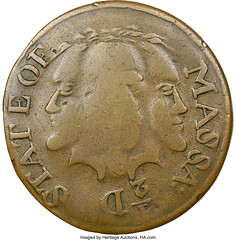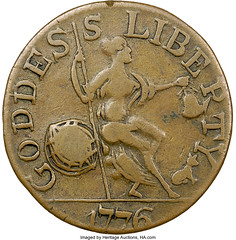
PREV ARTICLE
NEXT ARTICLE
FULL ISSUE
PREV FULL ISSUE
THE 1776 JANUS COPPERHeritage Auctions cataloger David Stone published an article on the mysterious Janus Copper in the Spring/Summer 2018 issue of The Intelligent Collector, a Heritage house publication. With
permission, here it is in its entirety. Thank you! -Editor
  The 1776 Janus copper is among the rarest and most enigmatic coins in American numismatics. A single specimen is known, a celebrated rarity since the earliest days of the hobby. Traditionally, the Janus copper was believed to be a privately produced pattern for a proposed Massachusetts half-cent copper coinage that was never issued. This view held sway until about 20 years ago, when some numismatists advanced the theory that the coin was a 19th century fabrication, perhaps the work of someone like Thomas Wyatt, the perpetrator of some scandalous forgeries that were discovered in 1856, or C.W. Betts, who began striking his more-innocent reproductions and fantasies around 1860. Numismatists at Heritage Auctions recently discovered correspondence that indicates the Janus copper was known to early numismatists before Wyatt and Betts began their operations, making it impossible for them to be the authors of this piece. Matthew Stickney was the first owner of record of this coin and, until now, the first-known numismatic reference to the Janus copper was believed to be the description of this piece in Montroville W. Dickeson’s American Numismatical Manual, published in 1859. The design of the coin features three conjoined heads on the obverse, with the legend “STATE OF” on the left, “MASSA:” on the right, and the denomination “½ D” below. Unfortunately, Dickeson only saw a rubbing of the coin, which is heavily worn on the central obverse, with the middle head nearly effaced. The rubbing seemed to show only two heads, leading Dickeson and others to call this piece the Janus copper, after the two-headed god of beginnings in Roman mythology. The reverse of the coin shows a seated figure of Liberty (or Britannia). A globe appears in the lower left field and a small animal (either a dog or cat) is at her feet. The legend “GODDESS LIBERTY” hugs the border, with the date 1776 in the exergue. In The Early Coins of America, published in 1875, Sylvester Sage Crosby noted: “The only specimen known of this curious pattern is in the collection of Matthew A. Stickney, Esq., and was found with an engraved piece (see plate VII, No. 9,) and some proof impressions from plates for continental paper money engraved by Paul Revere; from this circumstance Mr. Stickney is inclined to the opinion that they were the work of that engraver. However, this may be, the Pine tree cent, and this Halfpenny sufficiently resemble each other in their workmanship, to be considered the work of the same artist. They were probably private enterprises, as no mention of them is found upon any records.” When Heritage numismatists in 2015 examined Stickney’s papers, which are preserved in the Phillips Library at the Peabody Essex Museum, a May 5, 1854, letter was discovered from New York City numismatist Charles Ira Bushnell to Stickney that specifically asked about the Janus copper. The letter reads, in part: “I have understood that you had in your possession a coin bearing the following description, Obv: a head with 3 faces. Rev: a figure resembling Britannia. Legends: ‘State of Massa: ½ d’ ‘Goddess of Lib:’ date ‘1776.’ ” Bushnell wanted to examine the coin for a prospective work on early U.S. coinage he hoped to publish, but apparently never did. This letter predates Dickeson’s work by five years, and pushes numismatic knowledge of the Janus copper to a date before either Wyatt or Betts was operating. It seems likely that Stickney had the coin for some time before Bushnell wrote his letter, and the coin grades VF35 NGC, indicating it was carried as a pocket piece or circulated for a significant period before Stickney acquired it. If Paul Revere struck the coin in 1776 and carried it as a pocket piece for many years before his death in 1818, that could account for the coin’s worn appearance. On the other hand, opponents of the “Pattern Theory” point out that the abbreviation “MASSA” (for Massachusetts) was not in general use in 1776, and the denomination seems to be incorrect for a half cent, unless D was meant to refer to the English symbol d, for pence, which comes from the Roman denarius. The Bushnell letter does nothing to answer these objections, and it may be that the Janus copper is a 19th century fantasy piece but, if so, it is certainly from an earlier period than previously believed. David Stone adds: The Bushnell-Stickney letter from the the Peabody Essex Museum is fascinating, from a bibliophilic perspective, as it outlines a major work by Bushnell that was never actually published. According to this missive, and a follow-up letter he sent later, Bushnell did a remarkable amount of work on this project and was pretty far along with it when he contacted Stickney, but David Fanning says he never heard of any publication by Bushnell on early American coinage. I think he must have turned the whole project over to Crosby 20 years later, as Crosby thanked him in his Introduction for “much of the results of his labors.” The letter is quite lengthy. Interesting! Great treasures await the researcher willing to look far and wide for source material. A number of such troves exist in museum and historical society archives across the country. Perhaps
someday many of these will be digitized by the Newman Numismatic Portal. -Editor
To read the complete article, see page 80: Wayne Homren, Editor The Numismatic Bibliomania Society is a non-profit organization promoting numismatic literature. See our web site at coinbooks.org. To submit items for publication in The E-Sylum, write to the Editor at this address: whomren@gmail.com To subscribe go to: https://my.binhost.com/lists/listinfo/esylum All Rights Reserved. NBS Home Page Contact the NBS webmaster 
|